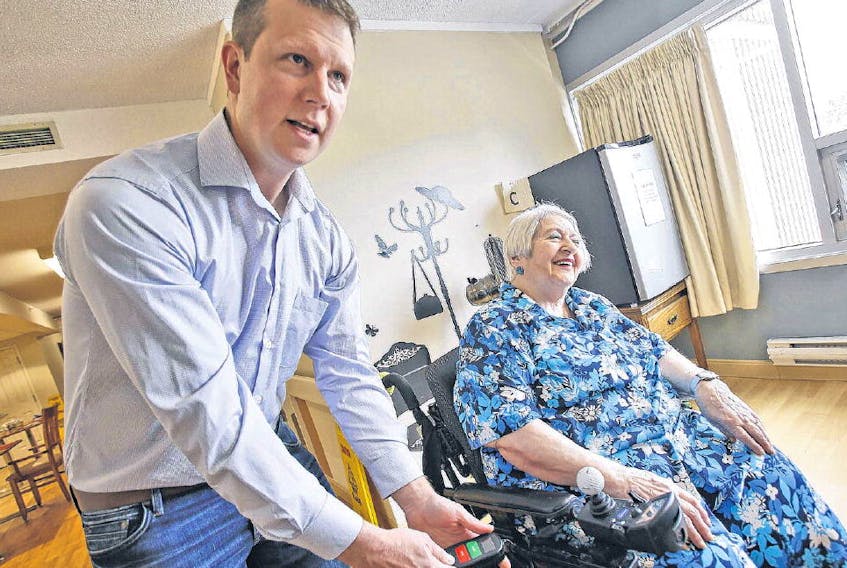“People ask, why didn’t we think of this before?” says Matt MacKenzie, the Nova Scotia inventor of a new medical device.
It allows a caregiver — or a person slumped over in a wheelchair — to re-position simply by pressing a button on a hand-held remote control.
“It’s a simple solution to a huge problem,” says MacKenzie.
His patented prototype is called the Paraglide.The remote control uses Bluetooth to connect with electronics inside a cylinder that attaches easily to the back of any make of wheelchair. As the cylinder rotates, it gently winds a fabric sheet placed under the seated person, drawing the individual fully upright again.
“It’s like a medical winch,” explains MacKenzie. “Instead of pulling a car out of a ditch you are gently pulling someone back into a properly seated position.”
Asked to describe the sensation, Northwood resident Ann Hicks says she can “barely” feel herself moving. She uses the Paraglide remote up to eight times a day to re-position her body.
Hicks, who suffers from severe osteoarthritis and a foot injury, says it means, “I don’t have to get a caregiver all the time. I don’t have to say, ‘Excuse me, can you pull me back in the chair? I’m too far forward.’ This allows me to do it myself. I’ve always liked being independent, so since I got this, it’s been wonderful.”
The Paraglide saves or remembers each time the body shifts; 10 people at Northwood have been field testing the system for the
past five months. Its current weight limit is 300 pounds.
MacKenzie says the recorded data show that even residents whose hands shake too much to use the remote are being repositioned more frequently by caregivers. He says that’s because the device makes it “faster and less burdensome on staff than if they have to use the overhead lift.”
The conventional mechanical lift takes a minimum of 10 minutes to engage, compared to 30 seconds using the Paraglide.
Most nursing homes in Nova Scotia have a “zero lift” policy to discourage workers from physically moving residents without either calling a second caregiver or using the mechanical lift. It was introduced to combat the problem of increasing workplace injuries that result in staff shortages and higher claims through workers’ compensation. In 2015, the WCB paid out $37 million to workers injured in home care, long-term care, and hospital settings. Health-care workers filed three times more claims than construction workers.
More than 80 per cent of those injuries were due to lifting or repositioning people, according to Charting our Course, Workplace Safety Report and Recommendations released this June by the safety association for health-care workers. In 2016, the report noted the increase in work-related injuries resulted in the equivalent of 320 full-time home care, longterm care, and special care home workers being absent from work for a full year. This was up 17 per cent from 274 workers in 2009.
The Paraglide device that repositions without lifting also has the potential to reduce the risk of bedsores or pressure injuries, another significant problem. The Mayo Clinic recommends moving people once an hour to prevent pressure injuries. The guideline in Nova Scotia is once every two hours, a benchmark the president of the Nova Scotia Nurses’ Union has previously suggested is unlikely to be met in long-term care facilities unless more staff are hired.
“We’d like to believe that if technology exists that will both increase movement for wheelchair users AND prevent caregiver injuries, it will be viewed in the same light as steel-toed boots on construction sites: a no-brainer,” says Carmen MacKenzie, the marketing vice-president for MacKenzie Healthcare Technologies.
Her husband Matt was originally contacted by Northwood five years ago to see if he would be interested in manufacturing a device designed by some mechanical engineering students from the Nova Scotia Community College to assist residents who had fallen over in their chairs.
“We asked how our staff could safely and comfortably reposition residents without putting themselves at risk of injury,” said Janet Simm, president and CEO of Northwood. “Northwood remains involved throughout Paraglide’s development, and our staff and residents continue to provide knowledge and feedback on the product.”
NSCC students had designed a fabric sling that slid under the person seated in a wheelchair and was attached to a belt worn by the caregiver. The belt allowed the caregiver to use his or her body weight to pull the person back to a comfortable position. But concerns about the time it took to adjust the belt as well as pressure on knees and backs meant staff stopped using the sling.
A year went by before Matt MacKenzie took a second look. He decided to automate the manual process to one controlled by electronics. The machinist already owned and operated a successful business in Dartmouth and Musquodoboit Harbour called MacKenzie Atlantic, where 23 employees serve customers in the defence, aerospace, oil and gas, and environmental fields.
Over the past two years, the inventor estimates “well over $500,000 has been spent” to research and develop the Paraglide, with the cost shared between the National Research Council and MacKenzie Healthcare Technologies.
The start-up’s biggest challenge is yet to come:convincing the provincial government — as well as privately owned nursing homes — that there’s a business case for buying the medical device. At an estimated price point of $1,800-$2,400 per unit (depending on whether it is a bulk purchase by a facility or a single purchase for at-home care), MacKenzie claims the Paraglide will save money paid out in disability claims and overtime. Besides reducing workplace injuries, it could also prevent pressure injuries, which — aside from hospitalization costs — create severe pain and have been implicated in the deaths of some nursing home residents.
Statistics released by the province last month showed that 153 residents were being treated for severe bedsores. Using current provincial guidelines, repositioning those 153 residents every two hours during a 12-hour shift would take 153 hours of labour and require hiring 19 additional people. MacKenzie says using the Paraglide — which takes 30 seconds instead of 10 minutes to reposition a resident — would take just 7.4 hours a day and require only one new staff hire.
And there’s more. According to Wounds Canada (formerly the Canadian Association of Wound Care), the average cost to treat a person with a severe Stage 3 or Stage 4 bedsore is $3,616 each month. Using the most recent provincial statistic of 153 persons afflicted, that works out to $553,248 a month. Medical experts say much of that cost could be avoided if people were turned or repositioned more often.
MacKenzie says his Paraglide prototype has received patents in the Canada, U.S., and Japan, but that it will take another six-eight months to “commercialize” before the first product is for sale. That’s because the printed circuit boards or “brains” of the Class 1 medical device must be upgraded to reflect learnings from its reallife trial at the Northwood complex in Halifax.
The 40-year-old inventor says it’s only because of the dedicated staff at MacKenzie Atlantic — his core machining business — that he can now devote most of his time to fine-tuning the promising technology, which he hopes will eventually create exports and new manufacturing jobs on the Eastern Shore where he and his family have settled.









